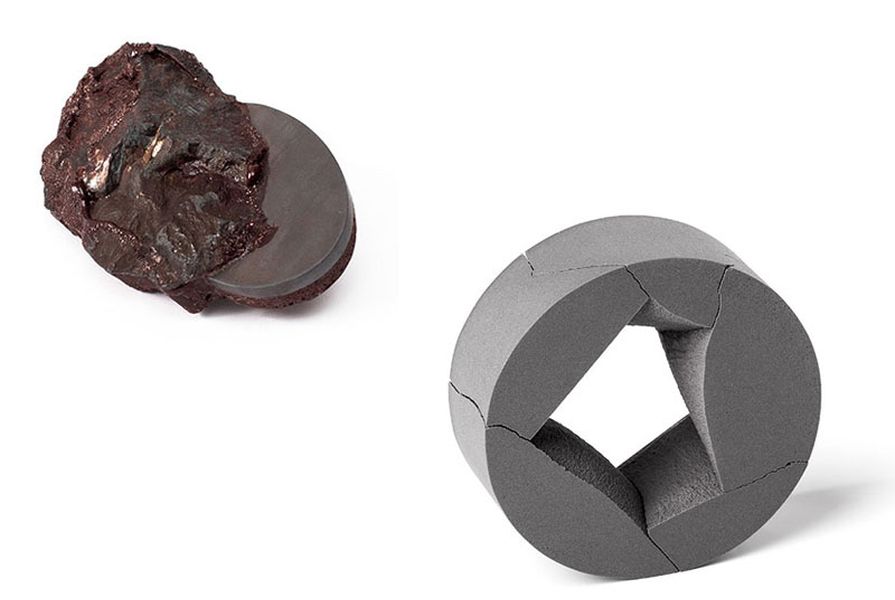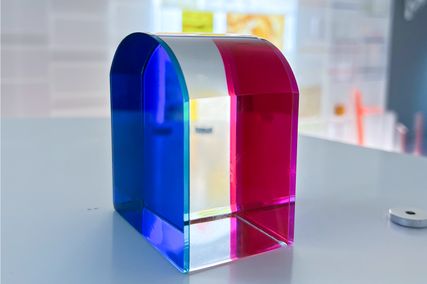In August last year the Mari Funaki Award for Contemporary Jewellery awarded Patricia Correia Domingues and Sara Gackowska each with the prize in the emerging artist category. Both jewellers were unknown to the three judges (Warwick Freeman, Simon Cottrell and Julie Ewington) but left a deep impression on them for the artistic maturity of their work.
At the time I wrote a review for Craft International magazine where I remarked how Domingues and Gackowska play with “the Japanese notion of wabi-sabi, an aesthetic principle where imperfection plays a great part in engendering beauty in an object.” This is even more evident in Surfacing, an exhibition of the two jewellers’ work at Gallery Funaki, where we can admire a whole collection of pieces by the two artists and witness their search for perfection in the imperfect.
Coincidentally, both Domingues and Gackowska work with stone – or, as we will see later, with the idea of stone, which gives this show a very coherent aesthetic. Katie Scott, the gallery director, has been able to display the work of one artist alongside the other in such a way that each piece becomes a counterpoint to the next and simultaneously a continuity of experience. The fact that the artists had never met until the week of the opening makes the event an even greater feat of curatorial farsightedness.
Sara Gackowska,Transgression, brooch, 2015, hematite, bio-resin, silver
Image: Courtesy the artist and Gallery Funaki
I say counterpoint because the theme of the natural versus the artificial is played beautifully by the adjacency of Dominques’ pieces, which for this exhibition are all in artificial stone, and Gackowska’s ones, which are all in a natural stone and bio-resin or fabric.
Domingues, who has been making jewellery since she was 15, studying and training in Portugal, Spain, Estonia and Germany, has also worked with natural stone. For example, sodalite, a blue gemstone which she deploys with great effect by marrying it with arkansas (a stone used mainly as a sharpening tool) and at times also with lapis lazuli or quartz. Her thesis Borders is a study on the edge between contrasting materials.
She says that stone can be ugly, or at least represent the crass nature of commercial jewellery, but she was fascinated by the possibility of it and went looking to discover if she could find a way into the material. Thus, she started by creating “atmospheres” for the stones by superimposing them with photos of landscapes as a way to re-present the stone. In turn, I assume this led her to create the “suggested landscapes” we see in her pieces dating from 2013.
Domingues deploys the edge, or the line, between the various stones and other materials as a leitmotif. Sometimes the edge is skilfully erased so that the object appears made of one material only, but strangely so because of the seamlessness she achieves, while at other times the object is clearly made of the two contrasting materials and the edge is the main protagonist. In the latter case, the materials are often naturally occurring ones such as plaster or wood fibres (reconstructed wood) in combination with man-made ones such as Corian or artificial stone.
Patricia Correia Domingues, Set Free & Matter, brooch, 2015, necuron, steel.
Image: Courtesy the artist and Gallery Funaki
For this show at Gallery Funaki, Domingues’ efforts concentrate very precisely on creating the illusion that we are looking at naturally occurring cracks in real stones or at natural forms, when in fact we are looking at Necuron, artificial ivory and artificial coral, formed or shattered to suggest the infinite variety of patterns and stone formations in nature. The effect she creates is a veritable conjuring of the natural from the artificial, but this is no mere mimicry. Invention is at the centre of each piece, leaving us to wonder: what stone is that which can break in ever decreasing spiralling patterns, or in a series of horizontal lines resembling the armature of a beetle? And what stone would break in such complex ways as appear in her pair of brooches Duality?
Sara Gackowska, Calm Before the Storm, brooch, 2013, in hematite, bio-resin, silver.
Image: Courtesy the artist and Gallery Funaki
This same spirit of invention is demonstrated in a compatible but fundamentally different way by Sara Gackowska, who has studied in Poland and Finland. At first glance, the similarity in scale and shape of her objects to those mentioned above, as well as the use of surface cracking as a motif would make us believe in a common provenance of ideas. However, Gackowska’s work is propelled by the way materials can be transformed into different states through the work of nature or the artist. For example, prior to working with stone, the artist made pieces in charcoal and amber because both materials derive from wood.
For the past two years, Gackowska has been working with hematite, a stone that takes its name from the Greek word haima, meaning blood, which she polishes to a uniform metallic grey and combines with bio-resin mixed with the blood-coloured powder that is the by-product of the cutting process.
In Surfacing, Gackowska’s works range from brooches to necklaces. Some brooches are quite ambiguous, as their scale resembles that of an object rather than jewellery. Most combine the stone with the bio-resin by layering the two or encasing and embedding one within the other. This creates a contrast between the metallic sheen of the polished stone and the porosity of the resin. These brooches appear as new geological forms that can be worn next to the body as objects that offer both comfort through touch, while seeking the attention jewellery is designed to attract through their lustre.
Patricia Correia Domingues, Duality, brooches, 2015, artificial coral, steel.
Image: Courtesy the artist and Gallery Funaki
Gackowska achieves an intimacy with the body, especially with her two necklaces that combine fabric with hematite and remind me of Membrane (brooch 2013), her winning piece for the Mari Funaki Award, where the lustrous layer of stone sits over the more giving, almost fleshy, mass of bio-resin. By re-uniting the two materials, she engages us in a kind of storytelling. As I look at the show I start to wonder if she is familiar with the saying “you can’t squeeze blood from a stone,” because she has managed to do exactly that – literally, but also metaphorically through the dark and visceral quality of her work.
In Surfacing, Gackowska and Domingues demonstrate the primacy of the material as the generator of the creative process. As Gackowska says: “Contact with the material is the most important for me… [and] is the factor that gives me the most pleasure from work.” Both artists have taken us on a material journey from which we can start to imagine the exciting possibilities of this frontier so elegantly opened by them.
Surfacing is an exhibition of works by Patricia Correia Domingues and Sara Gackowska at Gallery Funaki Melbourne and runs until 20 June, 2015.
























